A 64 × 128 3D-Stacked SPAD Image Sensor for Low-Light Imaging
Abstract
1. Introduction
2. Methods
2.1. Chip Architecture
2.2. Pixel and Readout Circuits
2.3. Digital Logic Control
2.4. Denoise Processing
3. Results and Discussion
3.1. Measurement System
3.2. Pixel Characteristics
3.3. Low-Light Imaging
3.4. Comparison with Previous Chips
4. Conclusions
Author Contributions
Funding
Institutional Review Board Statement
Informed Consent Statement
Data Availability Statement
Conflicts of Interest
References
- Cova, S.; Longoni, A.; Andreoni, A. Towards picosecond resolution with single-photon avalanche diodes. Rev. Sci. Instrum. 1981, 52, 408–412. [Google Scholar] [CrossRef]
- Niclass, C.; Favi, C.; Kluter, T.; Gersbach, M.; Charbon, E. A 128 × 128 single-photon imager with on-chip column-level 10b time-to-digital converter array capable of 97 ps resolution. In Proceedings of the 2008 IEEE International Solid-State Circuits Conference-Digest of Technical Papers, San Francisco, CA, USA, 3–7 February 2008; pp. 44–46. [Google Scholar]
- Tian, N.; Wang, Z.; Ma, K.; Yang, X.; Qi, N.; Liu, J.; Wu, N.; Dou, R.; Liu, L. A 128 × 128 SPAD LiDAR sensor with column-parallel 25 ps resolution TA-ADCs. J. Semicond. 2024, 45, 082201. [Google Scholar]
- Ogi, J.; Takatsuka, T.; Hizu, K.; Inaoka, Y.; Zhu, H.; Tochigi, Y.; Tashiro, Y.; Sano, F.; Murakawa, Y.; Nakamura, M.; et al. A 124-dB dynamic-range SPAD photon-counting image sensor using subframe sampling and extrapolating photon count. IEEE J. Solid-State Circuits 2021, 56, 3220–3227. [Google Scholar] [CrossRef]
- Ota, Y.; Morimoto, K.; Sasago, T.; Shinohara, M.; Kuroda, Y.; Endo, W.; Maehashi, Y.; Maekawa, S.; Tsuchiya, H.; Abdelghafar, A.; et al. A 0.37 W 143 dB-dynamic-range 1Mpixel backside-illuminated charge-focusing SPAD image sensor with pixel-wise exposure control and adaptive clocked recharging. In Proceedings of the 2022 IEEE International Solid-State Circuits Conference (ISSCC), San Francisco, CA, USA, 20–26 February 2022; pp. 94–96. [Google Scholar]
- Henderson, R.K.; Johnston, N.; Hutchings, S.W.; Gyongy, I.; Al Abbas, T.; Dutton, N.; Tyler, M.; Chan, S.; Leach, J. A 256 × 256 40 nm/90 nm CMOS 3D-stacked 120 dB dynamic-range reconfigurable time-resolved SPAD imager. In Proceedings of the 2019 IEEE International Solid-State Circuits Conference (ISSCC), San Francisco, CA, USA, 17–21 February 2019; pp. 106–108. [Google Scholar]
- Kumagai, O.; Ohmachi, J.; Matsumura, M.; Yagi, S.; Tayu, K.; Amagawa, K.; Matsukawa, T.; Ozawa, O.; Hirono, D.; Shinozuka, Y.; et al. A 189 × 600 back-illuminated stacked SPAD direct time-of-flight depth sensor for automotive LiDAR systems. In Proceedings of the 2021 IEEE International Solid-State Circuits Conference (ISSCC), San Francisco, CA, USA, 13–22 February 2021; pp. 110–112. [Google Scholar]
- Ximenes, A.R.; Padmanabhan, P.; Lee, M.J.; Yamashita, Y.; Yaung, D.N.; Charbon, E. A 256 × 256 45/65 nm 3D-stacked SPAD-based direct TOF image sensor for LiDAR applications with optical polar modulation for up to 18.6 dB interference suppression. In Proceedings of the 2018 IEEE International Solid-State Circuits Conference (ISSCC), San Francisco, CA, USA, 11–15 February 2018; pp. 96–98. [Google Scholar]
- Zhang, C.; Lindner, S.; Antolović, I.M.; Pavia, J.M.; Wolf, M.; Charbon, E. A 30-frames/s, 252 × 144 SPAD Flash LiDAR with 1728 Dual-Clock 48.8-ps TDCs, and Pixel-Wise Integrated Histogramming. IEEE J. Solid-State Circuits 2019, 54, 1137–1151. [Google Scholar] [CrossRef]
- Han, S.H.; Park, S.; Chun, J.H.; Choi, J.; Kim, S.J. A 160 × 120 Flash LiDAR Sensor with Fully Analog-Assisted In-Pixel Histogramming TDC Based on Self-Referenced SAR ADC. In Proceedings of the 2024 IEEE International Solid-State Circuits Conference (ISSCC), San Francisco, CA, USA, 18–22 February 2024; pp. 112–114. [Google Scholar]
- Gyongy, I.; Calder, N.; Davies, A.; Dutton, N.A.; Duncan, R.R.; Rickman, C.; Dalgarno, P.; Henderson, R.K. A 256 × 256, 100-kfps, 61% Fill-Factor SPAD Image Sensor for Time-Resolved Microscopy Applications. IEEE Trans. Electron Devices 2017, 65, 547–554. [Google Scholar] [CrossRef]
- Ulku, A.C.; Bruschini, C.; Antolović, I.M.; Kuo, Y.; Ankri, R.; Weiss, S.; Michalet, X.; Charbon, E. A 512 × 512 SPAD image sensor with integrated gating for widefield FLIM. IEEE J. Sel. Top. Quantum Electron. 2018, 25, 6801212. [Google Scholar] [CrossRef] [PubMed]
- Wayne, M.; Ulku, A.; Ardelean, A.; Mos, P.; Bruschini, C.; Charbon, E. A 500 × 500 dual-gate SPAD imager with 100% temporal aperture and 1 ns minimum gate length for FLIM and phasor imaging applications. IEEE Trans. Electron Devices 2022, 69, 2865–2872. [Google Scholar] [CrossRef]
- Huang, T.Y.; Huang, H.H.; Liu, C.H.; Lin, S.D.; Lee, C.Y. A Stack-Based In-Pixel Storage Circuit for SPAD Photon Counting. In Proceedings of the 2023 IEEE International Symposium on Circuits and Systems (ISCAS), Monterey, CA, USA, 21–25 May 2023; pp. 1–5. [Google Scholar]
- Katz, A.; Shoham, A.; Vainstein, C.; Birk, Y.; Leitner, T.; Fenigstein, A.; Nemirovsky, Y. Passive CMOS single photon avalanche diode imager for a gun muzzle flash detection system. IEEE Sens. J. 2019, 19, 5851–5858. [Google Scholar] [CrossRef]
- Villa, F.; Severini, F.; Madonini, F.; Zappa, F. SPADs and SiPMs arrays for long-range high-speed light detection and ranging (LiDAR). Sensors 2021, 21, 3839. [Google Scholar] [CrossRef]
- Piron, F.; Morrison, D.; Yuce, M.R.; Redouté, J.M. A review of single-photon avalanche diode time-of-flight imaging sensor arrays. IEEE Sens. J. 2020, 21, 12654–12666. [Google Scholar] [CrossRef]
- Lu, X.; Law, M.K.; Jiang, Y.; Zhao, X.; Mak, P.I.; Martins, R.P. A 4-μm diameter SPAD using less-doped N-well guard ring in baseline 65-nm CMOS. IEEE Trans. Electron Devices 2020, 67, 2223–2225. [Google Scholar] [CrossRef]
- Morimoto, K.; Ardelean, A.; Wu, M.L.; Ulku, A.C.; Antolovic, I.M.; Bruschini, C.; Charbon, E. Megapixel time-gated SPAD image sensor for 2D and 3D imaging applications. Optica 2020, 7, 346–354. [Google Scholar] [CrossRef]
- Al Abbas, T.; Dutton, N.A.W.; Almer, O.; Pellegrini, S.; Henrion, Y.; Henderson, R.K. Backside illuminated SPAD image sensor with 7.83 μm pitch in 3D-stacked CMOS technology. In Proceedings of the 2016 IEEE International Electron Devices Meeting (IEDM), San Francisco, CA, USA, 3–7 December 2016; pp. 196–199. [Google Scholar]
- Charbon, E.; Bruschini, C.; Lee, M.J. 3D-stacked CMOS SPAD image sensors: Technology and applications. In Proceedings of the 2018 25th IEEE International Conference on Electronics, Circuits and Systems (ICECS), Bordeaux, France, 9–12 December 2018; pp. 1–4. [Google Scholar]
- Morimoto, K.; Iwata, J.; Shinohara, M.; Sekine, H.; Abdelghafar, A.; Tsuchiya, H.; Kuroda, Y.; Tojima, K.; Endo, W.; Maehashi, Y.; et al. 3.2 megapixel 3D-stacked charge focusing SPAD for low-light imaging and depth sensing. In Proceedings of the 2021 IEEE International Electron Devices Meeting (IEDM), San Francisco, CA, USA, 11–16 December 2021; pp. 450–453. [Google Scholar]
- Berkovich, A.; Abshire, P. A low-light SPAD vision array. In Proceedings of the 2014 IEEE International Symposium on Circuits and Systems (ISCAS), Melbourne, VIC, Australia, 1–5 June 2014; pp. 1861–1864. [Google Scholar]
- Ouh, H.; Johnston, M.L. Dual-mode, in-pixel linear and single-photon avalanche diode readout for low-light dynamic range extension in photodetector arrays. In Proceedings of the 2018 IEEE Custom Integrated Circuits Conference (CICC), San Diego, CA, USA, 8–11 April 2018; pp. 1–4. [Google Scholar]
- Issartel, D.; Gao, S.; Pittet, P.; Cellier, R.; Golanski, D.; Cathelin, A.; Calmon, F. Architecture optimization of SPAD integrated in 28 nm FD-SOI CMOS technology to reduce the DCR. Solid-State Electron. 2022, 191, 108297. [Google Scholar] [CrossRef]
- Bronzi, D.; Villa, F.; Bellisai, S.; Tisa, S.; Tosi, A.; Ripamonti, G.; Zappa, F.; Weyers, S.; Durini, D.; Brockherde, W.; et al. Large-area CMOS SPADs with very low dark counting rate. In Proceedings of the Quantum Sensing and Nanophotonic Devices X, San Francisco, CA, USA, 2–7 February 2013; Volume 8631, pp. 241–248. [Google Scholar]
- Ito, K.; Otake, Y.; Kitano, Y.; Matsumoto, A.; Yamamoto, J.; Ogasahara, T.; Hiyama, H.; Naito, R.; Takeuchi, K.; Tada, T.; et al. A Back Illuminated 10 μm SPAD Pixel Array Comprising Full Trench Isolation and Cu-Cu Bonding with over 14% PDE at 940 nm. In Proceedings of the 2020 IEEE Electron Device Meeting (IEDM), San Francisco, CA, USA, 12–18 December 2020; pp. 347–350. [Google Scholar]
- Takatsuka, T.; Ogi, J.; Ikeda, Y.; Hizu, K.; Inaoka, Y.; Sakama, S.; Watanabe, I.; Ishikawa, T.; Shimada, S.; Suzuki, J.; et al. A 3.36-μm-Pitch SPAD Photon-Counting Image Sensor Using a Clustered Multi-Cycle Clocked Recharging Technique with an Intermediate Most-Significant-Bit Readout. IEEE J. Solid-State Circuits 2024, 59, 1137–1145. [Google Scholar] [CrossRef]
- Oike, Y. Evolution of image sensor architectures with stacked device technologies. IEEE Trans. Electron Devices 2021, 69, 2757–2765. [Google Scholar] [CrossRef]
- Shimada, S.; Otake, Y.; Yoshida, S.; Endo, S.; Nakamura, R.; Tsugawa, H.; Ogita, T.; Ogasahara, T.; Yokochi, K.; Inoue, Y.; et al. A Back Illuminated 6 μm SPAD Pixel Array with High PDE and Timing Jitter Performance. In Proceedings of the 2021 IEEE International Electron Device Meeting (IEDM), San Francisco, CA, USA, 11–16 December 2021; pp. 446–449. [Google Scholar]
- Wang, Z.; Tian, N.; Yang, X.; Feng, P.; Dou, R.; Yu, S.; Liu, J.; Wu, N.; Liu, L. Overview of imaging technology based on single photon avalanche diode. Integr. Circuits Embed. Syst. 2024, 24, 10–25. [Google Scholar]
- Lim, S.; Cheon, J.; Chae, Y.; Jung, W.; Lee, D.H.; Kwon, M.; Yoo, K.; Ham, S.; Han, G. A 240-frames/s 2.1-Mpixel CMOS image sensor with column-shared cyclic ADCs. IEEE J. Solid-State Circuits 2011, 46, 2073–2083. [Google Scholar] [CrossRef]
- Park, J.E.; Lim, D.H.; Jeong, D.K. A reconfigurable 40-to-67 dB SNR, 50-to-6400 Hz frame-rate, column-parallel readout IC for capacitive touch-screen panels. IEEE J. Solid-State Circuits 2014, 49, 2305–2318. [Google Scholar] [CrossRef]
- Liu, M.; Cai, Z.; Wang, Z.; Zhou, S.; Law, M.K.; Liu, J.; Ma, J.; Wu, N.; Liu, L. A 3 THz CMOS Image Sensor. IEEE J. Solid-State Circuits 2024, 1–14. [Google Scholar] [CrossRef]
- Cao, J.; Zhang, Z.; Qi, N.; Liu, L.; Wu, N. A 16 × 1 Pixels 180 nm CMOS SPAD-based TOF Image Sensor for LiDAR Applications. Acta Photonica Sin. 2019, 48, 0704001. [Google Scholar]
- Palubiak, D.P.; Li, Z.; Deen, M.J. After pulsing characteristics of free-running and time-gated single-photon avalanche diodes in 130-nm CMOS. IEEE Trans. Electron Devices 2015, 62, 3727–3733. [Google Scholar] [CrossRef]
- Yang, X.; Yao, C.; Kang, L.; Luo, Q.; Qi, N.; Dou, R.; Yu, S.; Feng, P.; Wei, Z.; Liu, J.; et al. A Bio-Inspired Spiking Vision Chip Based on SPAD Imaging and Direct Spike Computing for Versatile Edge Vision. IEEE J. Solid-State Circuits 2023, 59, 1883–1898. [Google Scholar] [CrossRef]
- Intermite, G.; Warburton, R.E.; McCarthy, A.; Ren, X.; Villa, F.; Waddie, A.J.; Taghizadeh, M.R.; Zou, Y.; Zappa, F.; Tosi, A.; et al. Enhancing the fill-factor of CMOS SPAD arrays using microlens integration. In Proceedings of the Photon Counting Applications, Prague, Czech Republic, 13–15 April 2015; Volume 9504, pp. 64–75. [Google Scholar]
- Antolovic, I.M.; Ulku, A.C.; Kizilkan, E.; Lindner, S.; Zanella, F.; Ferrini, R.; Schnieper, M.; Charbon, E.; Bruschini, C. Optical-stack optimization for improved SPAD photon detection efficiency. In Proceedings of the Quantum Sensing and Nano Electronics and Photonics XVI, San Francisco, CA, USA, 2–7 February 2019; Volume 10926, pp. 359–365. [Google Scholar]
- Connolly, P.W.; Ren, X.; McCarthy, A.; Mai, H.; Villa, F.; Waddie, A.J.; Taghizadeh, M.R.; Tosi, A.; Zappa, F.; Henderson, R.K.; et al. High concentration factor diffractive microlenses integrated with CMOS single-photon avalanche diode detector arrays for fill-factor improvement. Appl. Opt. 2020, 59, 4488–4498. [Google Scholar] [CrossRef] [PubMed]
- Xu, T.; Chen, Q.; Bian, D.; Xu, Y. A Near-Infrared Single-Photon Detector for Direct Time-of-Flight Measurement Using Time-to-Amplitude-Digital Hybrid Conversion Method. IEEE Trans. Instrum. Meas. 2023, 73, 4500309. [Google Scholar] [CrossRef]
- Ma, J.; Zhang, D.; Elgendy, O.A.; Masoodian, S. A 0.19 e-rms read noise 16.7 Mpixel stacked quanta image sensor with 1.1 μm-pitch backside illuminated pixels. IEEE Electron Device Lett. 2021, 42, 891–894. [Google Scholar] [CrossRef]
- Zhang, C.; Lindner, S.; Antolovic, I.M.; Wolf, M.; Charbon, E. A CMOS SPAD imager with collision detection and 128 dynamically reallocating TDCs for single-photon counting and 3D time-of-flight imaging. Sensors 2018, 18, 4016. [Google Scholar] [CrossRef] [PubMed]
- Huang, H.H.; Huang, T.Y.; Liu, C.H.; Lin, S.D.; Lee, C.Y. 32 × 64 SPAD Imager Using 2-bit In-Pixel Stack-Based Memory for Low-Light Imaging. IEEE Sens. J. 2023, 23, 19272–19281. [Google Scholar] [CrossRef]
- Hu, J.; Liu, B.; Ma, R.; Liu, M.; Zhu, Z. A 32 × 32-pixel flash LiDAR sensor with noise filtering for high-background noise applications. IEEE Trans. Circuits Syst. I Regul. Pap. 2022, 69, 645–656. [Google Scholar] [CrossRef]
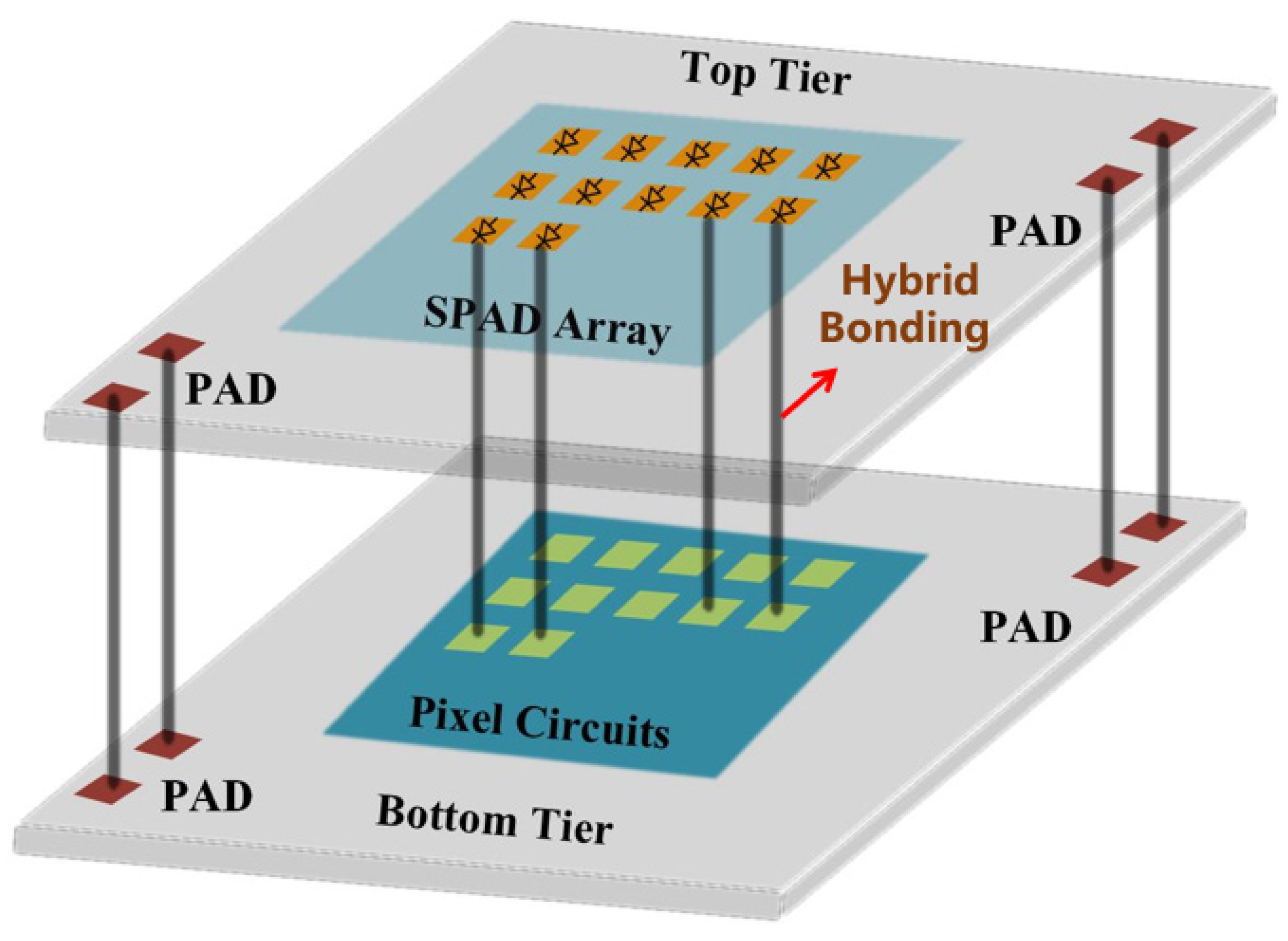
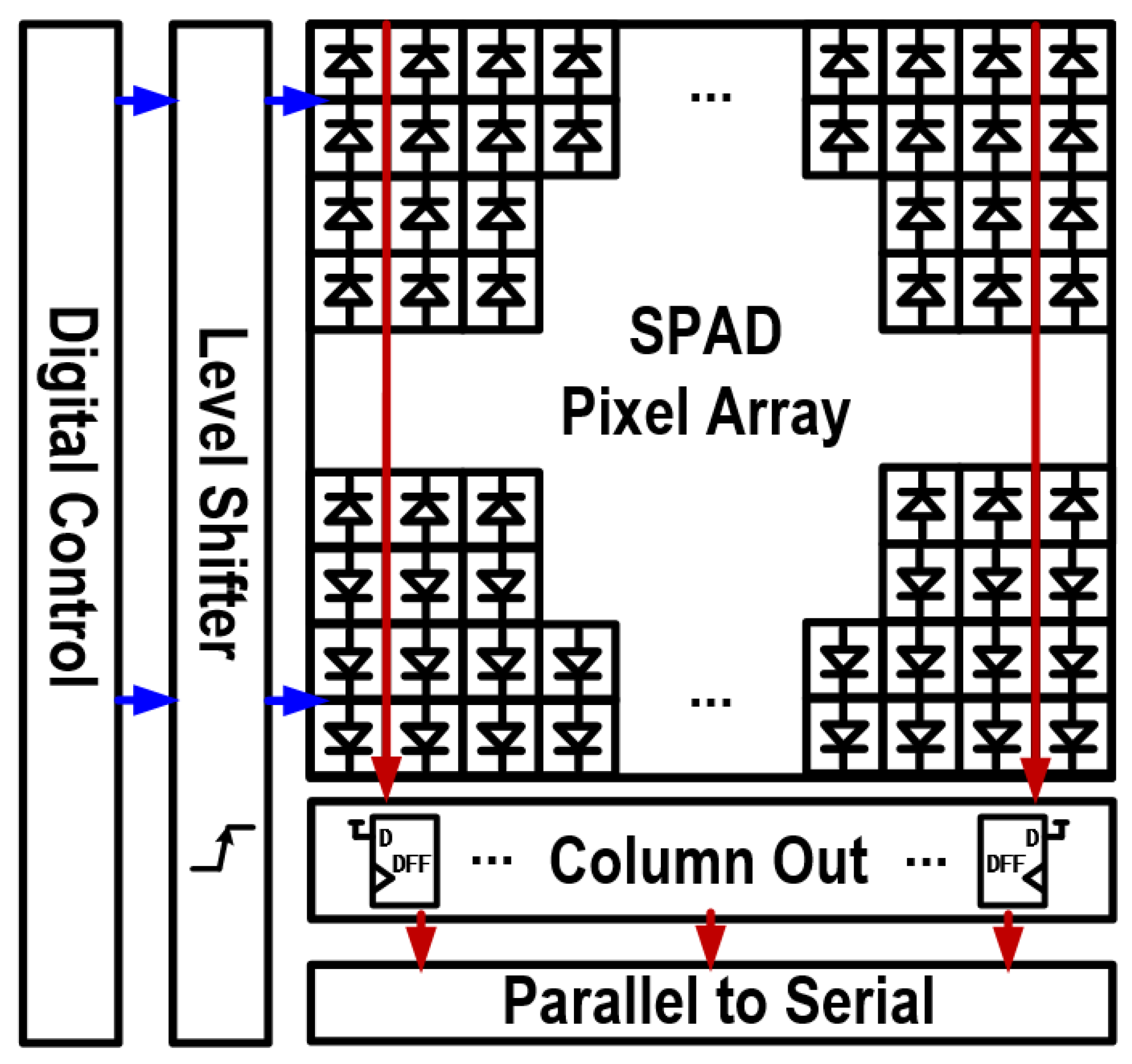
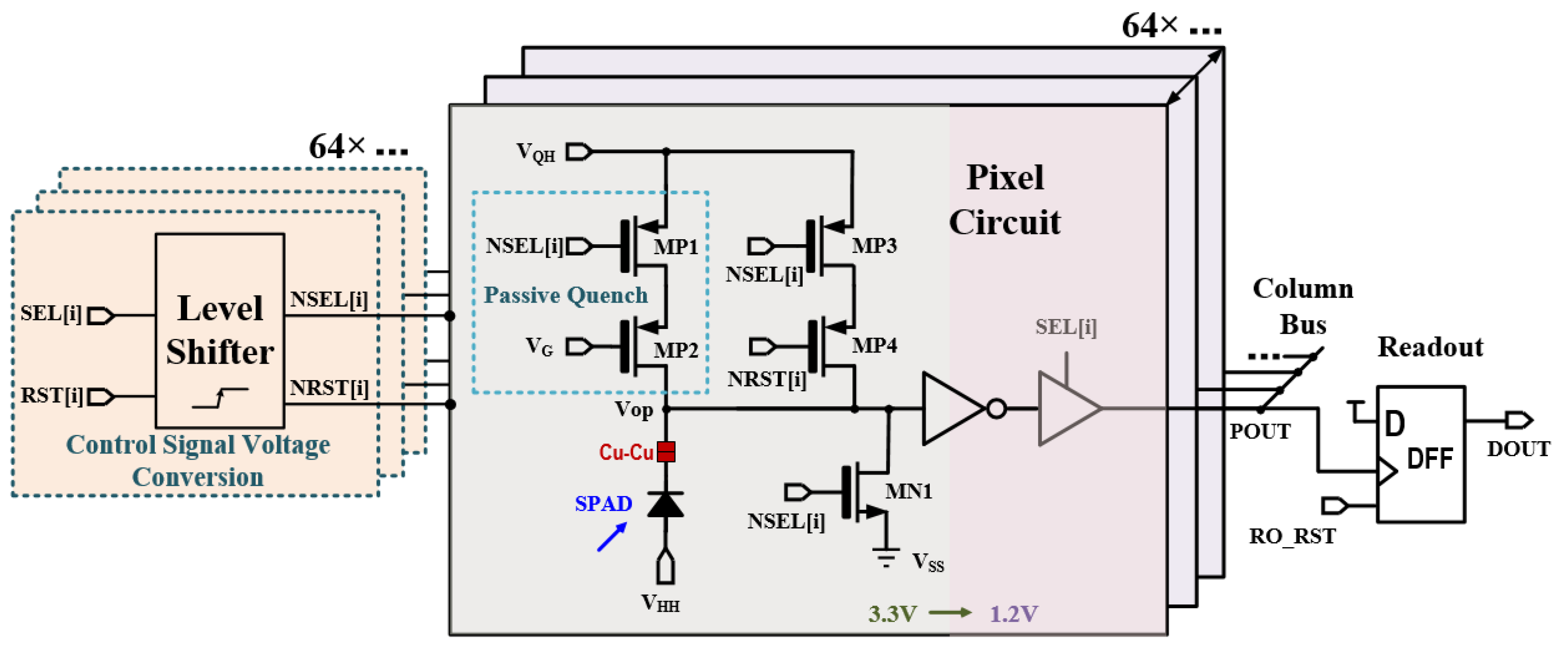
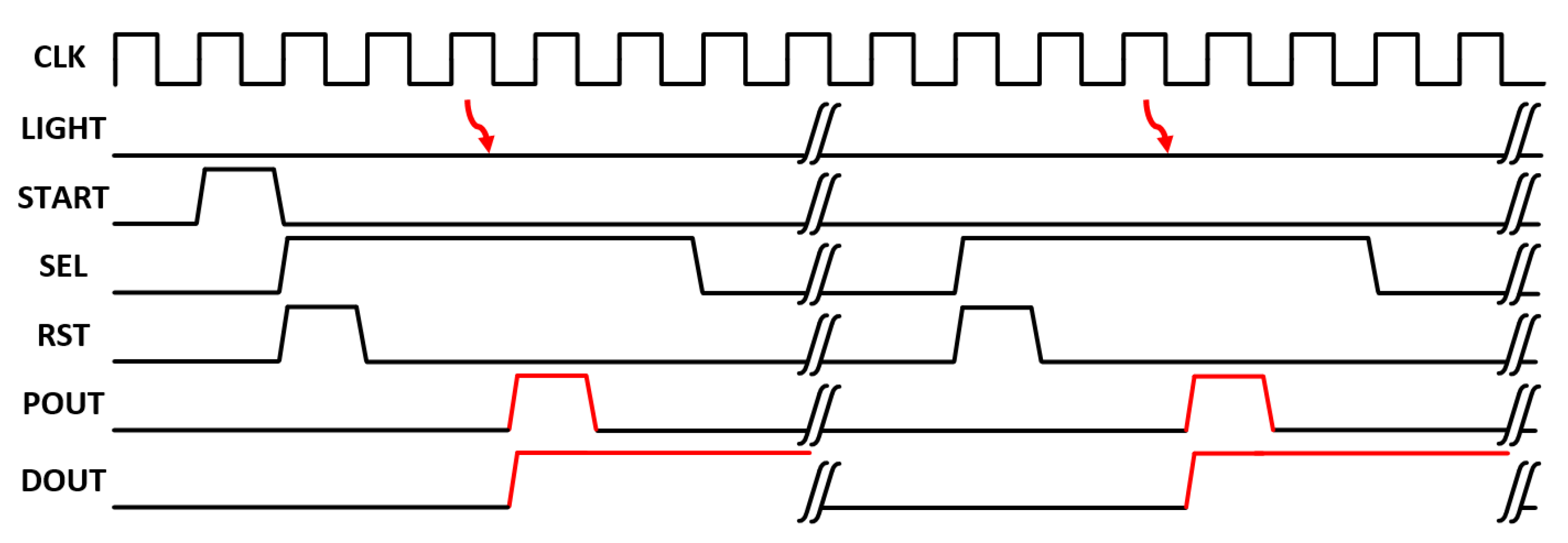
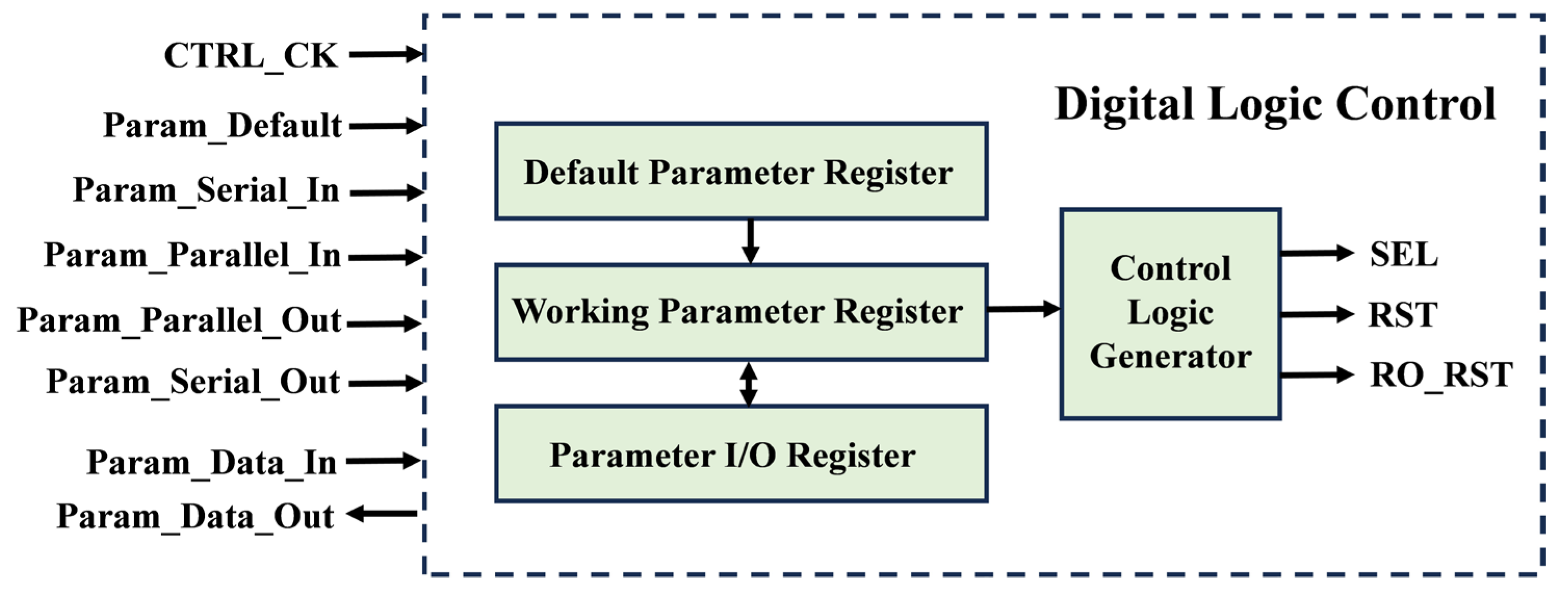


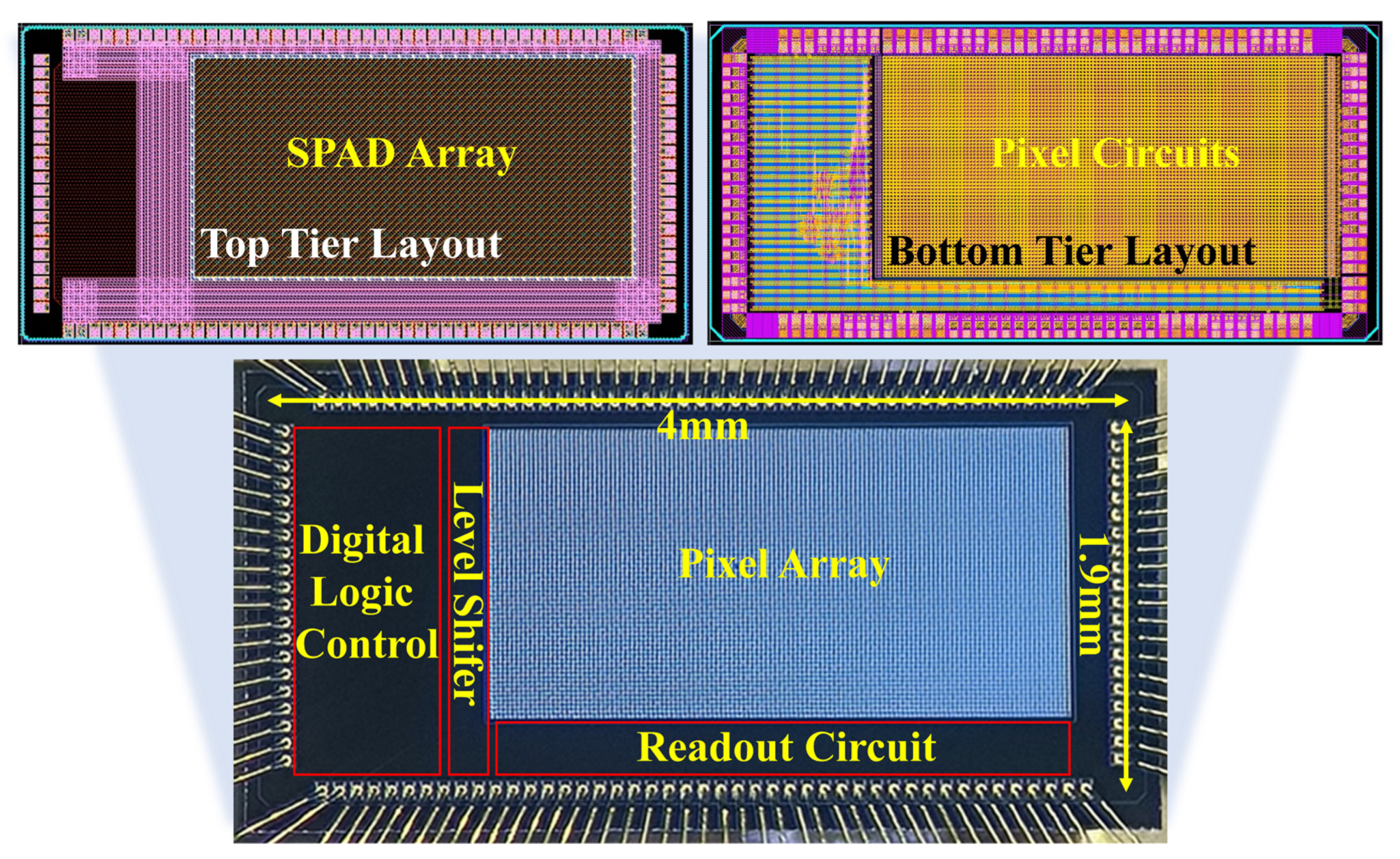

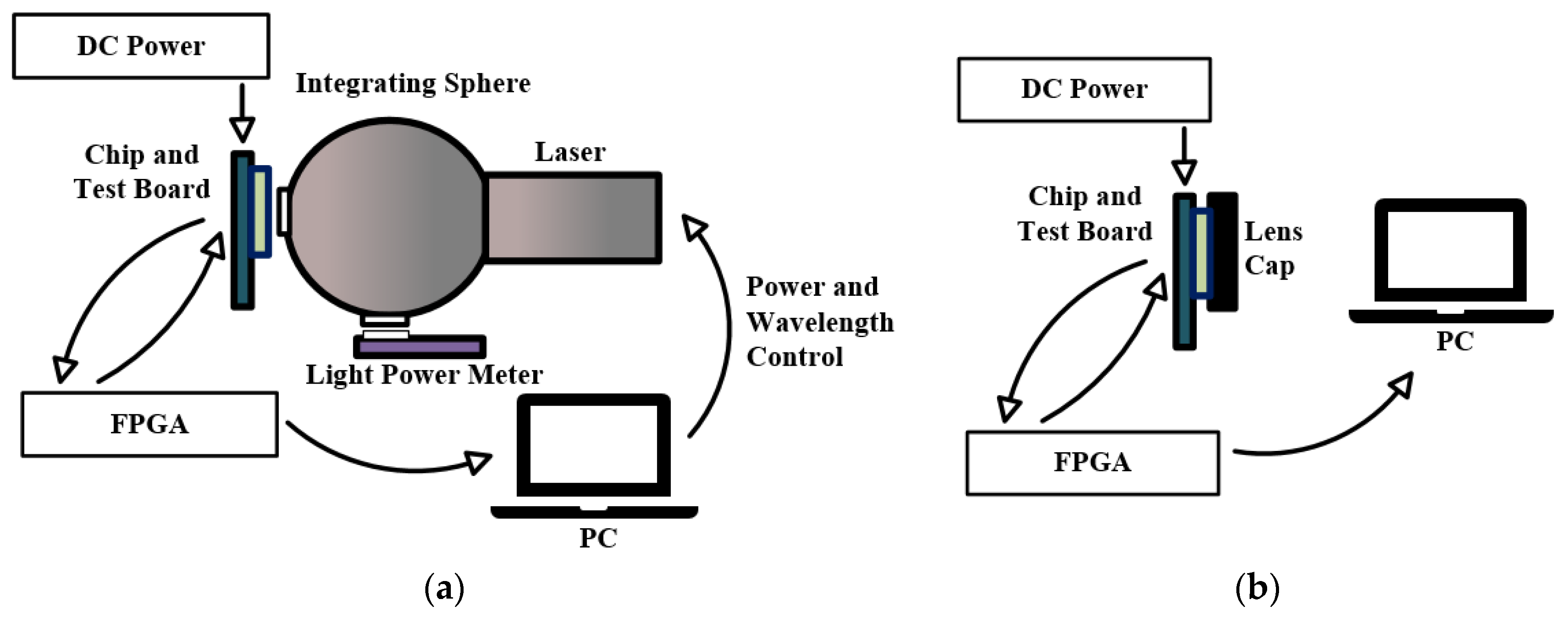
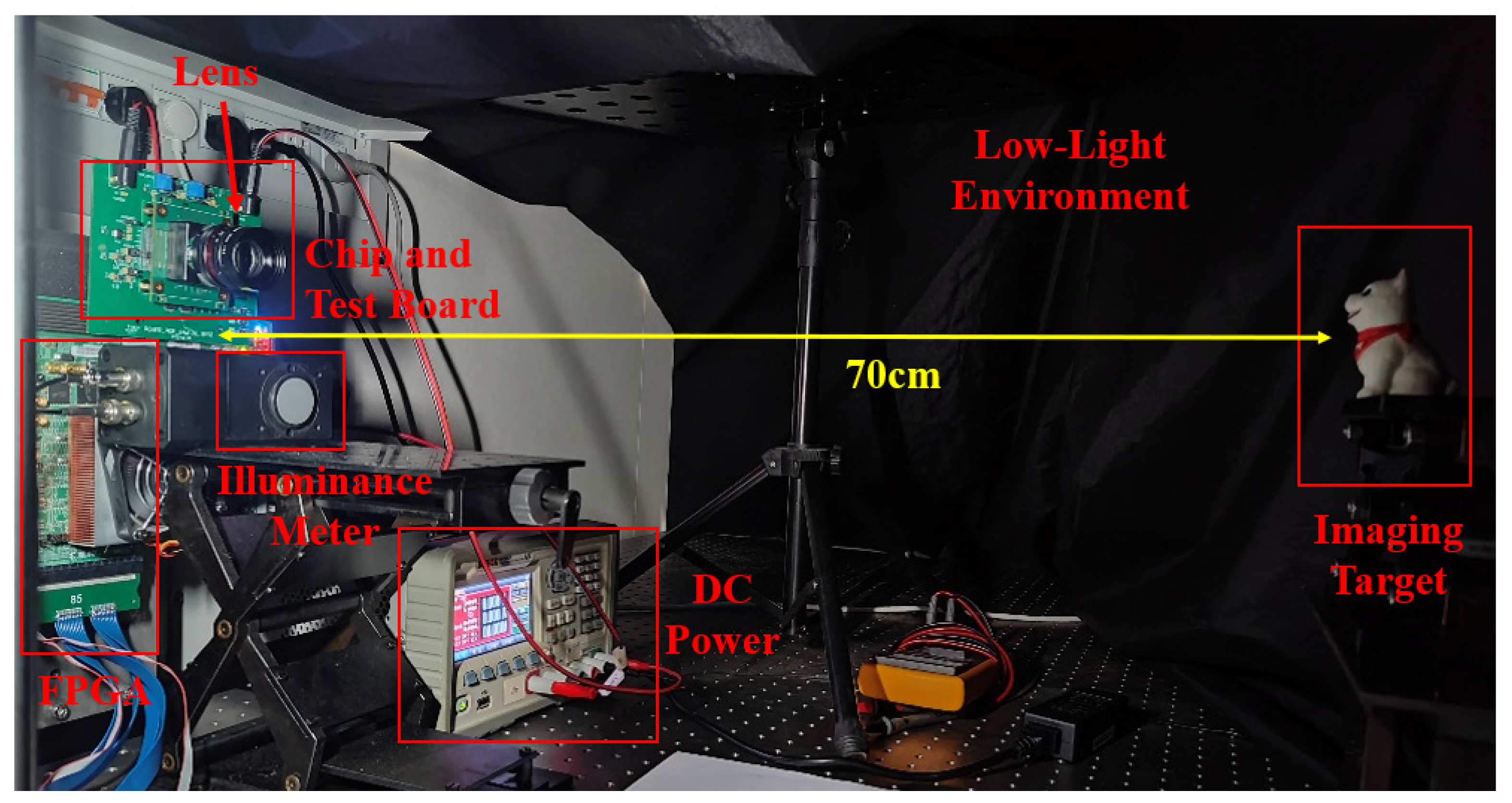

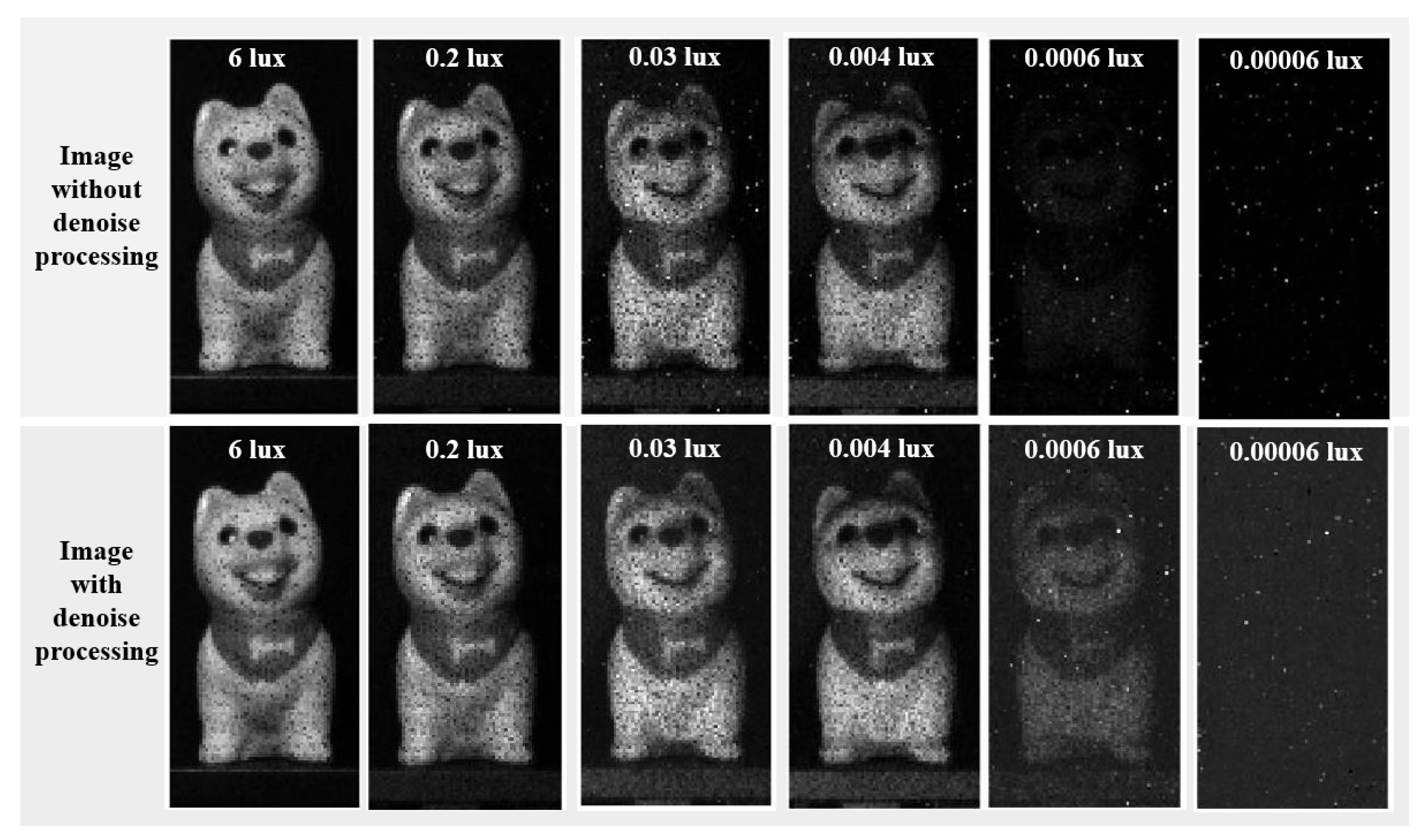
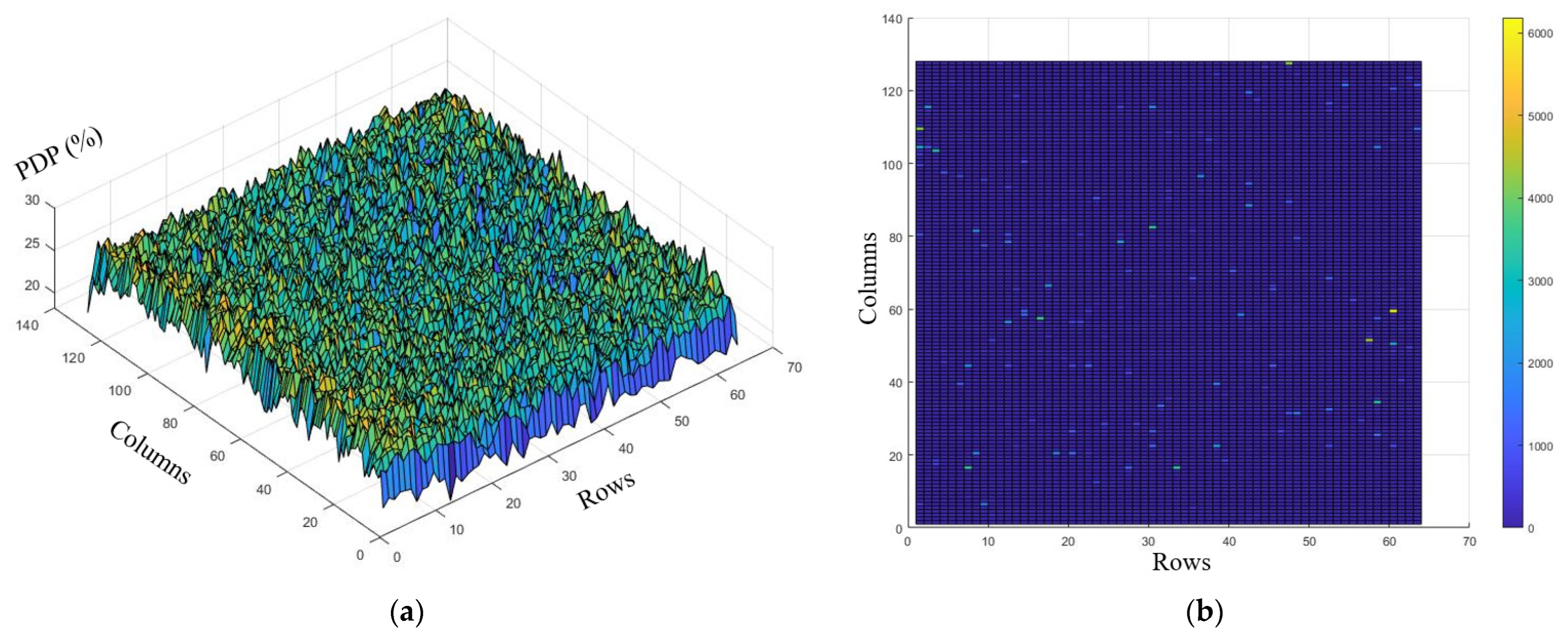
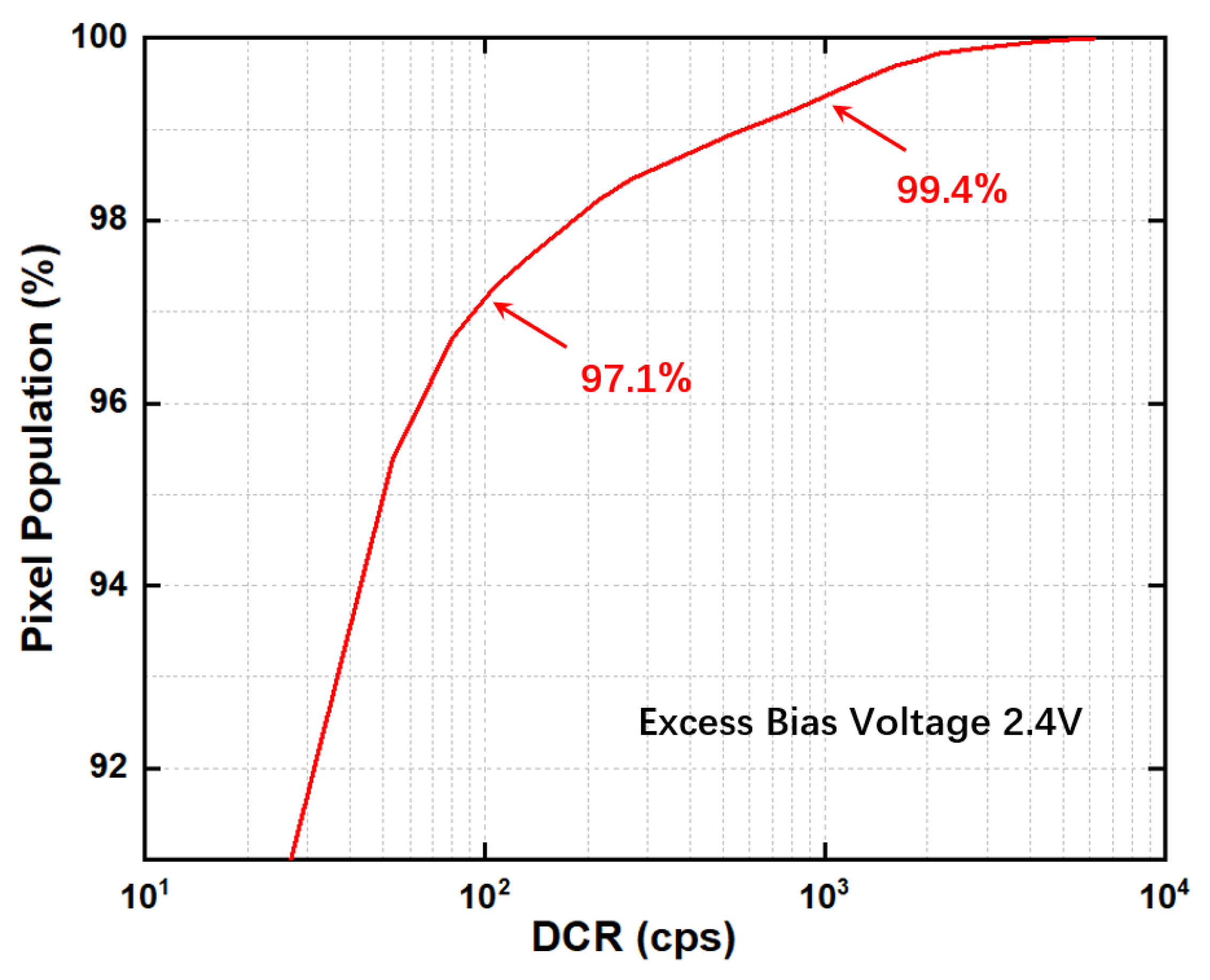
| Unit | This Work | [44] | [45] | [43] | |
|---|---|---|---|---|---|
| Technology | - | 180 nm/130 nm Stacked BSI | 180 nm HV FSI | 180 nm HV FSI | 180 nm CIS FSI |
| Array Size | - | 64 × 128 | 32 × 64 | 32 × 32 | 32 × 32 |
| Pixel Size | μm | 21 × 21 | 48 × 61 | 60 × 60 | 28.5 × 28.5 |
| Microlens | - | Yes | / | / | / |
| Fill Factor * | % | 38 | 13.4 | 7.2 | 28 |
| Peak PDP | % | 25.4 | 57 | 31 | 47.8 |
| Median DCR | cps | 41.5 | 810 | 1200 | 113 |
| Low-Light Imaging | lux | 10−4 | 10−1 ** | NA | NA |
Disclaimer/Publisher’s Note: The statements, opinions and data contained in all publications are solely those of the individual author(s) and contributor(s) and not of MDPI and/or the editor(s). MDPI and/or the editor(s) disclaim responsibility for any injury to people or property resulting from any ideas, methods, instructions or products referred to in the content. |
© 2024 by the authors. Licensee MDPI, Basel, Switzerland. This article is an open access article distributed under the terms and conditions of the Creative Commons Attribution (CC BY) license (https://creativecommons.org/licenses/by/4.0/).
Share and Cite
Wang, Z.; Yang, X.; Tian, N.; Liu, M.; Cai, Z.; Feng, P.; Dou, R.; Yu, S.; Wu, N.; Liu, J.; et al. A 64 × 128 3D-Stacked SPAD Image Sensor for Low-Light Imaging. Sensors 2024, 24, 4358. https://doi.org/10.3390/s24134358
Wang Z, Yang X, Tian N, Liu M, Cai Z, Feng P, Dou R, Yu S, Wu N, Liu J, et al. A 64 × 128 3D-Stacked SPAD Image Sensor for Low-Light Imaging. Sensors. 2024; 24(13):4358. https://doi.org/10.3390/s24134358
Chicago/Turabian StyleWang, Zhe, Xu Yang, Na Tian, Min Liu, Ziteng Cai, Peng Feng, Runjiang Dou, Shuangming Yu, Nanjian Wu, Jian Liu, and et al. 2024. "A 64 × 128 3D-Stacked SPAD Image Sensor for Low-Light Imaging" Sensors 24, no. 13: 4358. https://doi.org/10.3390/s24134358
APA StyleWang, Z., Yang, X., Tian, N., Liu, M., Cai, Z., Feng, P., Dou, R., Yu, S., Wu, N., Liu, J., & Liu, L. (2024). A 64 × 128 3D-Stacked SPAD Image Sensor for Low-Light Imaging. Sensors, 24(13), 4358. https://doi.org/10.3390/s24134358






